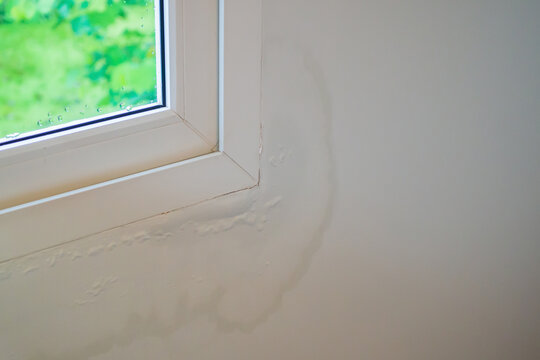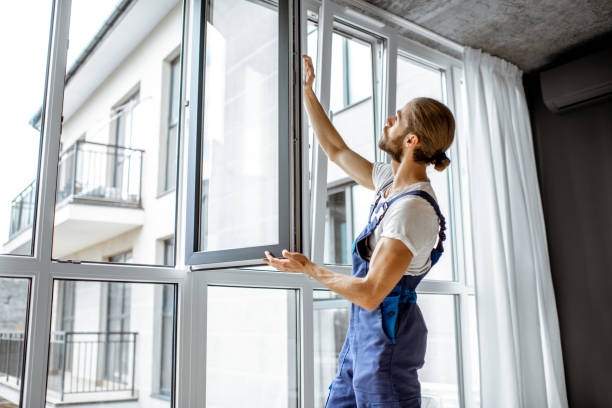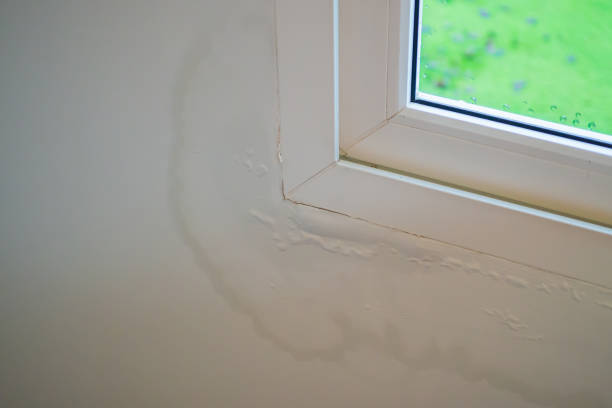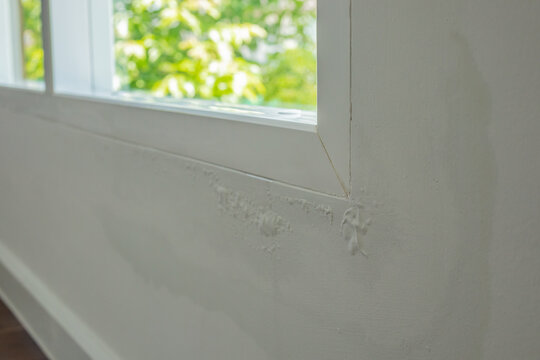A leaking window frame can result in more than just an annoying drip. Over time, the continuous seepage of water can lead to extensive damage to your property, including peeling drywall.
This issue can be both aesthetically displeasing and structurally concerning. This article will guide you through the process of identifying and rectifying the problem of a leaking window frame that causes drywall peeling.
A leaking window frame causing drywall to peel is a common yet significant issue faced by homeowners. This problem typically starts when water seeps through cracks or gaps in the window frame.
Over time, the continued water exposure leads to the deterioration of the surrounding wall materials, like your drywall. As the drywall absorbs moisture, it weakens and eventually starts to peel away, leaving an unsightly and potentially hazardous area in your home.
This issue, if left unchecked, can lead to more severe structural problems, necessitating costly repairs and replacements.
Identifying the Problem
Signs of a Leaking Window Frame
Water Stains
One of the most obvious signs of a leaking window frame is the presence of water stains around the window area. These stains usually appear as dark, discolored patches on the drywall.
Peeling Paint or Wallpaper
When water seeps through the window frame, it can cause paint or wallpaper to peel away from the wall. This is a clear indication that water is getting into places it shouldn’t be.
Mold or Mildew
The presence of mold or mildew around your window frame indicates a persistent moisture problem. Spores thrive in damp conditions, so their presence often signifies a leak.
Pooled Water
If you notice water pooling on your window sill or the floor beneath the window after a rainstorm, this could be a sign of a leak in the window frame.
Damaged Drywall
As previously mentioned, water seeping through a window frame can cause drywall to weaken and peel away. This is a significant warning sign that your window frame may be leaking.
How to Spot Drywall Peeling
Recognizing peeling drywall early on can save you from extensive structural damage and expensive repair costs. Drywall peeling usually begins subtly and may not be obvious at first glance.
To spot peeling drywall, look for irregularities in the surface of your walls. These can manifest as small bubbles, cracks, or patches where the drywall coating seems to be flaking away.
While examining, pay attention to the areas around windows, as they are often susceptible to moisture damage due to potential window frame leaks.
Not only should you look for areas where the drywall is peeling or flaking, but also look for discoloration or dampness. These signs can indicate the early stages of peeling drywall.
The texture of the wall might also change, feeling soft or crumbly to the touch, another telltale sign of impending peeling.
Understanding the Causes
Brief Explanation of Why Window Frames Leak

Window frames can leak due to a variety of reasons. Over time, weather conditions, such as heavy rain, snow, or temperature fluctuations, can cause the window sealant to degrade, leading to potential leaks.
Incorrect installation of windows can also result in leaks. Another common cause is condensation buildup, which happens when there’s a significant temperature disparity between the inside and outside of the window. This can lead to water seeping into the frames, causing them to leak.
Discussion on How Leaking Window Frames Lead to Drywall Peeling
When window frames leak, they allow moisture to seep into the surrounding areas. This moisture can cause a host of problems, including peeling drywall.
The moisture absorbed by the drywall weakens its integrity, causing the layers to separate and peel. If left unchecked, this moisture can propagate mold growth, causing further damage to the drywall and potential health risks.
Regular inspection and early detection of window frame leaks can help prevent peeling drywall, saving on costly repairs and maintaining a healthy living environment.
Prevention Measures
Maintenance Tips for Window Frames
Regular maintenance of window frames can prevent leaks and subsequent issues like peeling drywall. Start with a thorough inspection of the windows, checking for signs of wear and tear, such as chipping sealant or cracks in the frame.
Properly cleaning the window frames can also prevent the buildup of dust and mildew, which can exacerbate wear. Reapply sealant or caulk regularly, especially if there are signs of it degrading or pulling away from the frame.
In areas prone to harsh weather conditions, consider using weather-resistant sealants for better durability. Additionally, ensure proper ventilation to reduce condensation buildup, which can lead to leaks. Lastly, consider professional help if you notice persistent leaks despite your maintenance efforts.
Preventive Measures for Drywall Peeling
To prevent drywall from peeling, it’s crucial to keep it dry and to regulate humidity levels within the home. Employing dehumidifiers or air conditioners can help maintain a balanced indoor environment.
Good ventilation, particularly in areas prone to moisture like kitchens or bathrooms, can also prevent the buildup of dampness. If you notice any water leaks, address them immediately to avoid moisture from seeping into the drywall.
Water-resistant paint or primer can be used to provide an extra layer of protection for the drywall. Regular inspections for signs of peeling, such as bubbling, cracking, or discoloration, allow for early intervention and reduce the risk of extensive damage.
Steps to Fix a Leaking Window Frame
Tools and materials needed
To carry out the task of fixing a leaking window frame, you will need the following tools and materials:
- Screwdriver: This is necessary to remove any screws locking the window in place.
- Putty Knife: A putty knife is essential for removing old sealant or paint around the window frame.
- Sealant/Caulk: This is the material you’ll use to fill gaps and seal the window frame to prevent future leaks.
- Caulk Gun: A caulk gun is used to apply the sealant or caulk around the window frame.
- Paint: If the frame needs to be painted after sealing, have some matching paint on hand.
- Paintbrush: A suitable brush is required for applying the paint smoothly.
- Cloth or Rag: These are necessary to clean the area before and after work.
- Ladder: If the window is high up, you might need a ladder to reach it.
Step-by-Step Procedure
Step 1: Preparing the Area
Before starting, prepare the area around the window. Lay a cloth or rag under the window to collect any debris that may fall during the process. If the window is high up, set up your ladder securely.
Step 2: Removing the Old Sealant
Using the putty knife, carefully scrape away the old sealant or paint around the window frame. This will allow the new sealant to adhere better and create a more secure seal.
Step 3: Cleaning the Window Frame
Once all the old sealant is removed, clean the window frame thoroughly. This step is crucial as any dust or dirt left on the frame can compromise the effectiveness of the new sealant.
Step 4: Applying the New Sealant
Load the caulk gun with your chosen sealant. Apply an even bead of the sealant all around the frame, ensuring all gaps are filled. Smooth out the sealant with the putty knife for an aesthetically pleasing finish.
Step 5: Letting the Sealant Dry
Allow the sealant to dry according to the manufacturer’s instructions. It’s important not to rush this step as the sealant needs to be fully cured to be effective.
Step 6: Painting the Window Frame
Once the sealant is dry, you can repaint the window frame if necessary. Use a paintbrush to gently apply the paint, taking care not to get any on the window glass.
Step 7: Clean Up
After the paint has dried, clean up your workspace. Remove the cloth or rag and dispose of any debris safely.
Step 8: Regular Inspection
Regularly inspect the window frame for signs of leaks, peeling, or any other damage. Early detection can save you time and money on future repairs.
Related Topics:
Repairing the Peeling Drywall

Tools and Materials Needed
- Putty Knife
- Caulk Gun
- Sealant
- Paintbrush
- Paint
- Ladder
- Cleaning Cloth
- Dust Mask
- Protective Eyewear
- Disposable Gloves
- Trash Bag for Debris Removal
- Cleaning Solution for Window Frame
- Sandpaper for Peeling Drywall
- Primer
- Drywall Compound
- Drywall Tape
- Utility Knife
- Taping Knife
Step-by-Step Procedure for Repairing Peeling Drywall
Step 1: Safety First
Before you begin, ensure you’re wearing the necessary protective gear. This includes a dust mask, protective eyewear, and disposable gloves. Prepare your workspace by placing a drop cloth or an old sheet under the area where you’ll be working to catch any falling debris.
Step 2: Identify and Cut Away Damaged Drywall
Using your utility knife, carefully cut away the area of drywall that’s peeling. It’s important to remove all the damaged material to prevent the problem from spreading.
Step 3: Patch the Area
Next, cut a piece of drywall tape to fit over the area you’ve just cut away. Apply a layer of drywall compound over the area with the taping knife, then immediately press the drywall tape into the compound.
Step 4: Apply Drywall Compound
Once the tape is in place, apply another layer of drywall compound over it, extending the compound beyond the edges of the tape. This will help to blend the patch with the rest of the wall. Let the compound dry completely according to the manufacturer’s instructions.
Step 5: Sand and Prime
When the compound is dry, sand the area until it is smooth and blends in with the rest of the wall. Wipe away any dust with a damp cloth, then apply a coat of primer. Let the primer dry completely.
Step 6: Paint
Finally, paint the patched area to match the rest of the wall. If necessary, you may need to paint the entire wall to ensure a uniform color.
Step 7: Clean Up
Once the paint is dry, clean your workspace. Dispose of any debris and put away your tools. Regularly inspect the wall for signs of peeling in the future to catch any issues early.
Conclusion
In conclusion, a leaking window frame can lead to significant issues, including drywall peeling, which can escalate to severe structural problems if not addressed promptly. However, with the right knowledge and tools, you can successfully repair the leakage and restore your drywall.
This guide has provided comprehensive steps for identifying the problem, understanding its causes, undertaking prevention measures, and executing the repair process for both the leaking window frame and the peeling drywall.
By adhering to these instructions, you can ensure the longevity of your property’s structure and aesthetics, while avoiding future costly repairs. Regular inspections and maintenance can go a long way in preventing these issues from recurring.
FAQs
What are some signs of a leaking window frame that could lead to drywall peeling?
Some signs that a window frame is leaking include the presence of moisture or condensation on the inside of the window, visible water damage around the window frame such as discoloration or peeling paint, and a musty smell in the area around the window.
How often should I inspect my walls and window frames to prevent leakage and subsequent drywall peeling?
Regular inspections at least twice a year or after heavy rainfall are recommended. However, if you notice any signs of water damage or changes in your walls or window frames, such as discoloration, warping, or a musty smell, you should inspect them immediately.


1 thought on “Leaking Window Frame Drywall Peeling: Fixing And Repairing”